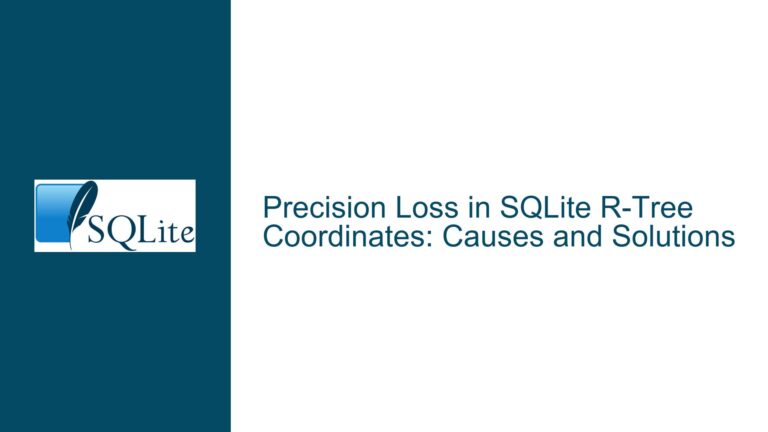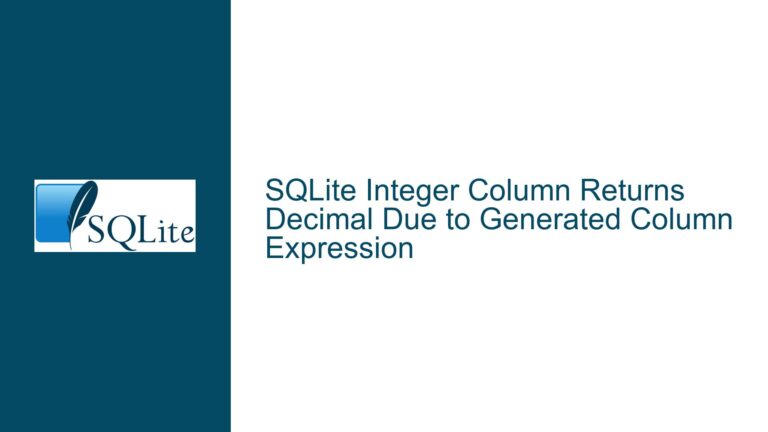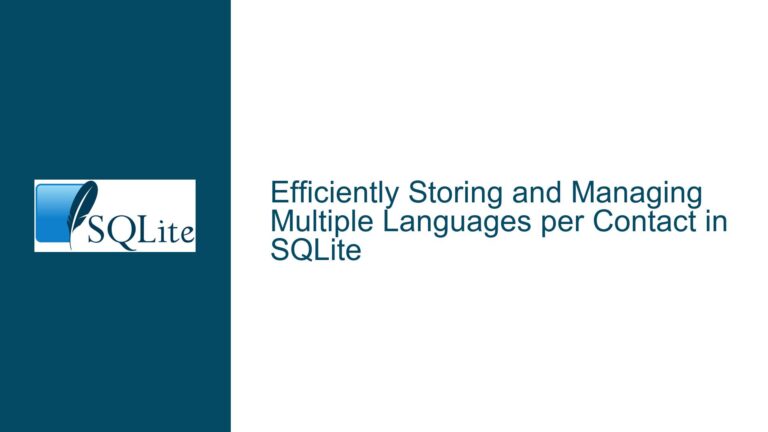Optimizing SQLite for Graph Editor: UUIDs, Diff/Merge, and Source Control Integration
Understanding the Challenges of UUIDs, Diff/Merge, and Source Control in SQLite
When developing a graph editor with SQLite as the backend, several critical challenges arise, particularly around unique node identification, database diffing/merging, and integration with source control systems. The primary concern is ensuring that nodes in the graph have unique identifiers that avoid collisions, especially in a collaborative environment where multiple users may be editing the graph simultaneously. UUIDs are a natural choice for this purpose due to their uniqueness, but their 128-bit size introduces inefficiencies when used as primary keys in SQLite. Additionally, the need to diff and merge graph changes in a source control management (SCM) environment complicates matters, as SQLite databases are not inherently designed for such workflows. This post will explore these challenges in detail, identify potential causes of inefficiencies, and provide actionable solutions to optimize SQLite for this use case.
Exploring the Limitations of UUIDs and SQLite’s Rowid Mechanism
The core issue with using UUIDs as primary keys in SQLite stems from the database’s internal handling of row identifiers (rowids). SQLite uses a 64-bit signed integer for rowids, which is efficient for indexing and storage. However, UUIDs are 128 bits, making them incompatible with SQLite’s rowid mechanism. This mismatch can lead to performance degradation, as SQLite must manage larger keys and potentially create additional indexes to handle the UUIDs. Furthermore, the use of UUIDs complicates diffing and merging operations, as the database’s internal structure may change even when the logical content remains the same. For example, a VACUUM operation can reorganize the database file, making it difficult for source control systems to track changes effectively.
One proposed alternative to UUIDs is the use of Snowflake IDs, which are 63-bit identifiers that combine a timestamp, machine ID, and sequence number. While Snowflake IDs are more compact than UUIDs, they rely on centralized machine ID assignment, which may not be practical in a distributed user environment. Additionally, Snowflake IDs introduce a dependency on accurate timestamps, which can be problematic if system clocks are not synchronized across users. Another approach is to use a composite key consisting of two 64-bit columns, such as a timestamp and user ID. However, this approach still requires careful management to avoid collisions and ensure efficient indexing.
Implementing Efficient Diff/Merge and Source Control Integration
To address the challenges of diffing and merging SQLite databases in a source control environment, it is essential to understand how SQLite stores data internally. SQLite uses fixed-size pages to store rows, with each page typically being 4 KB in size. While rows themselves are stored in a variable-length format, the use of fixed-size pages means that changes to the database file are localized to specific pages. This structure allows for efficient diffing at the page level, as only the modified pages need to be tracked. However, most source control systems, such as Git, are designed to handle text files and are not optimized for binary formats like SQLite databases. As a result, even minor changes to the database can result in large diffs, making it difficult to track changes effectively.
One solution to this problem is to use a custom diffing mechanism that operates at the SQL level rather than the binary level. By exporting the database to a text-based format, such as SQL dump files, it becomes possible to leverage existing source control tools for diffing and merging. This approach requires careful handling of primary keys and foreign key relationships to ensure consistency across merges. Another option is to use SQLite’s session extension, which tracks changes to the database at the row level. However, the session extension may not be suitable for all use cases, particularly when dealing with UUIDs or other non-standard primary keys.
Detailed Troubleshooting Steps, Solutions, and Fixes
To optimize SQLite for a graph editor with unique node identification and source control integration, follow these steps:
Evaluate Primary Key Options: Consider using a composite key consisting of a timestamp and user ID, or a custom hash function like SipHash, to generate unique identifiers that fit within SQLite’s 64-bit rowid limit. Ensure that the chosen method minimizes the risk of collisions and is efficient for indexing.
Implement Custom Diffing and Merging: Develop a custom diffing mechanism that operates at the SQL level by exporting the database to text-based SQL dump files. Use tools like
sqlite3to generate and apply diffs, ensuring that primary keys and foreign key relationships are preserved during merges.Leverage SQLite’s Session Extension: If the session extension is compatible with your primary key strategy, use it to track changes at the row level. This approach can simplify diffing and merging operations, but be aware of its limitations when dealing with non-standard primary keys.
Optimize Database Layout for Source Control: Minimize unnecessary changes to the database file by avoiding operations like
VACUUMthat can reorganize the file layout. Instead, focus on maintaining a consistent internal structure that facilitates efficient diffing.Integrate with Source Control Systems: Use a combination of binary and text-based formats to integrate SQLite databases with source control systems. For example, store the database in binary format for performance but generate SQL dump files for diffing and merging.
By following these steps, you can optimize SQLite for use in a graph editor, ensuring efficient unique node identification, seamless diffing and merging, and effective integration with source control systems.






